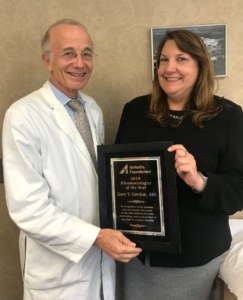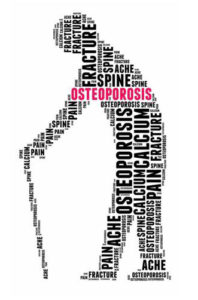Gary V. Gordon, MD, FACP, FACR, Chief of Rheumatology, Lankenau Medical Center, Wynnewood, PA received the 2018 Rheumatologist of the Year Award from The Arthritis Foundation. He is pictured with Holly Maddams, Executive Director of the Arthritis Foundation, Eastern PA. Dr. Gordon was honored on October 5, 2018 at The Arthritis Foundation’s Bone Bash, held at Mutter Museum of The College of Physicians of Philadelphia.
pictured with Holly Maddams, Executive Director of the Arthritis Foundation, Eastern PA. Dr. Gordon was honored on October 5, 2018 at The Arthritis Foundation’s Bone Bash, held at Mutter Museum of The College of Physicians of Philadelphia.
Tag Archives: osteoporosis
Why Am I Height Challenged?
 Everybody wants to maintain optimal height during their adult lifetime. But height loss is a common part of the aging process. We may notice tall elderly people with great posture, but unfortunately, they are a distinct minority.
Everybody wants to maintain optimal height during their adult lifetime. But height loss is a common part of the aging process. We may notice tall elderly people with great posture, but unfortunately, they are a distinct minority.
There are two kinds of height loss. All of sudden at a doctor’s office visit, you find out you are an inch shorter. Commonly heard is “I used to be 5’8 and now I’m 5’6; what happened?” The other height loss is more noticeable, being bent over. We don’t like that any better, but we’re more aware of that physical change which may be accompanied by pain or discomfort.
As we age, height loss often occurs as the soft discs, which sit between the vertebral bones in our backs lose water and don’t do their job, maintaining your previous height. This type of height loss is subtle and painless. More acute height loss is often accompanied by significant pain in the mid-back region, corresponding to the thoracic spine, resulting from a compression fracture or collapse of one of the bony vertebrae. We see a lot of this as a consequence to osteoporosis (a silent disease defined by a decrease in bone mass resulting in an increased risk of fracture). The most important piece of information you can seek is an evaluation as to why you have osteoporosis.
An x-ray or a DEXA bone density study is valuable to provide information about osteopenia (you might be in the beginning stage of possible height loss) fractures and/or osteoporosis, all of which can compromise height. The DEXA, which can include a lateral picture of the thoracic spine, will make the diagnosis of a compression fracture. If the fracture occurs without severe trauma such as a car accident or fall off a ladder, it is considered a fragility or low-impact fracture; an example is a fall from a standing position to the floor. Even if the DEXA results are normal, patients still need treatment for osteoporosis. Men need to be evaluated for causes of osteoporosis such as steroid exposure (i.e. prednisone) or low testosterone. More rare causes need evaluation for such problems as multiple myeloma, a form of cancer.
Sometimes, kyphoplasty, where a radiologist places “medical cement” into the collapsed vertebra, can prevent further height loss and stabilize the spine. It is vitally important to do everything possible to treat osteoporosis and vertebral compression fractures. Like dominoes, the first compression fracture is the greatest risk for the next one, so treatment and stabilization should be undertaken as soon as possible.
In addition to medical evaluation and tests, as with everything we do to maintain good health and a quality of life, here is what our bones and spine health deserve and benefit from: a nutritious and balanced diet, exercise and fresh air, and proper rest. Our bodies are fantastic machines that can benefit from proper maintenance!
Is Dr. Google Smarter Than My Doctor?
Most patients who are curious and comfortable using the internet, often go to Google to check out information that their doctor gave them during an office visit. Is Dr. Google always dependable or useful? Sometimes.
While online, patients visit websites, enter chat rooms or interact online with friends and family in the differential diagnosis of possibilities that might prove helpful in finding additional information, helping to facilitate a full and accurate diagnosis and treatment plan. On the other hand, not all websites, chat rooms or friends and family’s opinions are created equal. I have found the most dependable information on medical school-related websites such as Harvard, Johns Hopkins, Mayo Clinic, U Penn and Stanford University. In comparison and in my medical opinion, I often disagree with information presented on WebMD and Drugs.com, among other websites.
It is helpful in maintaining a good and trusted relationship with your doctor to ask whether information you have discovered makes sense in your medical condition, or case. Confronting your doctor and saying he or she is “wrong” and that you have discovered “correct” data from WebMD, for example, not only weakens your doctor-patient trust bond, but can burn bridges and end up being of little help. Today, patients want to be informed consumers. I applaud being curious and responsible in the quest for answers; this is our new normal. But some medical information available to patients online, even on trusted websites as above, can be easily misunderstood or read out of context, such as listed medication side effects, or even dangerous drug combinations. Every patient is an individual. Every medical condition is unique to each individual patient. Let your doctor who is your trusted medical partner and knows your personal medical history, listen to everything you have to share and about your concerns and address your diagnosis and treatment.
When watching TV drug commercials, if you are a patient with a certain condition or disease, you know the frightened reaction you may have when hearing about serious drug side effects, especially the biologics which doctors use to treat rheumatoid and psoriatic arthritis. Are they real side effects that could actually affect you? Yes and no. The drug manufacturer is concerned about liability and being sued for not stating a list of potential side effects, and after seeing the commercial, we ask ourselves, “Why would anyone in their right mind take on such risk?” For example, most of these commercials talk about cancer and lymphoma. To the best of my knowledge, there are no recent studies showing an increase in the frequency of solid tumors. Lymphomas occur more commonly in rheumatoid arthritis, regardless of whether patients are on a biologic (drug) agent, and it is still unclear whether the biologic drugs like Humira or Enbrel, increase the risk of lymphomas. Not treating an active disease like rheumatoid or psoriatic arthritis, can have its own obvious consequences.
So what is the conclusion? An ounce of prevention is worth a pound of cure. Be an informed consumer, discuss with your doctor and together, agree on the right treatment for you.


